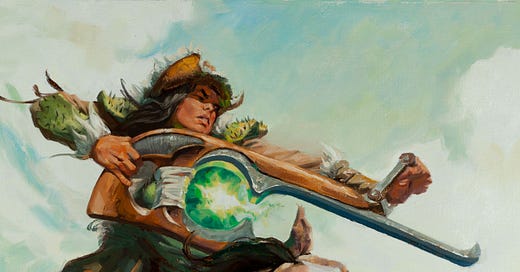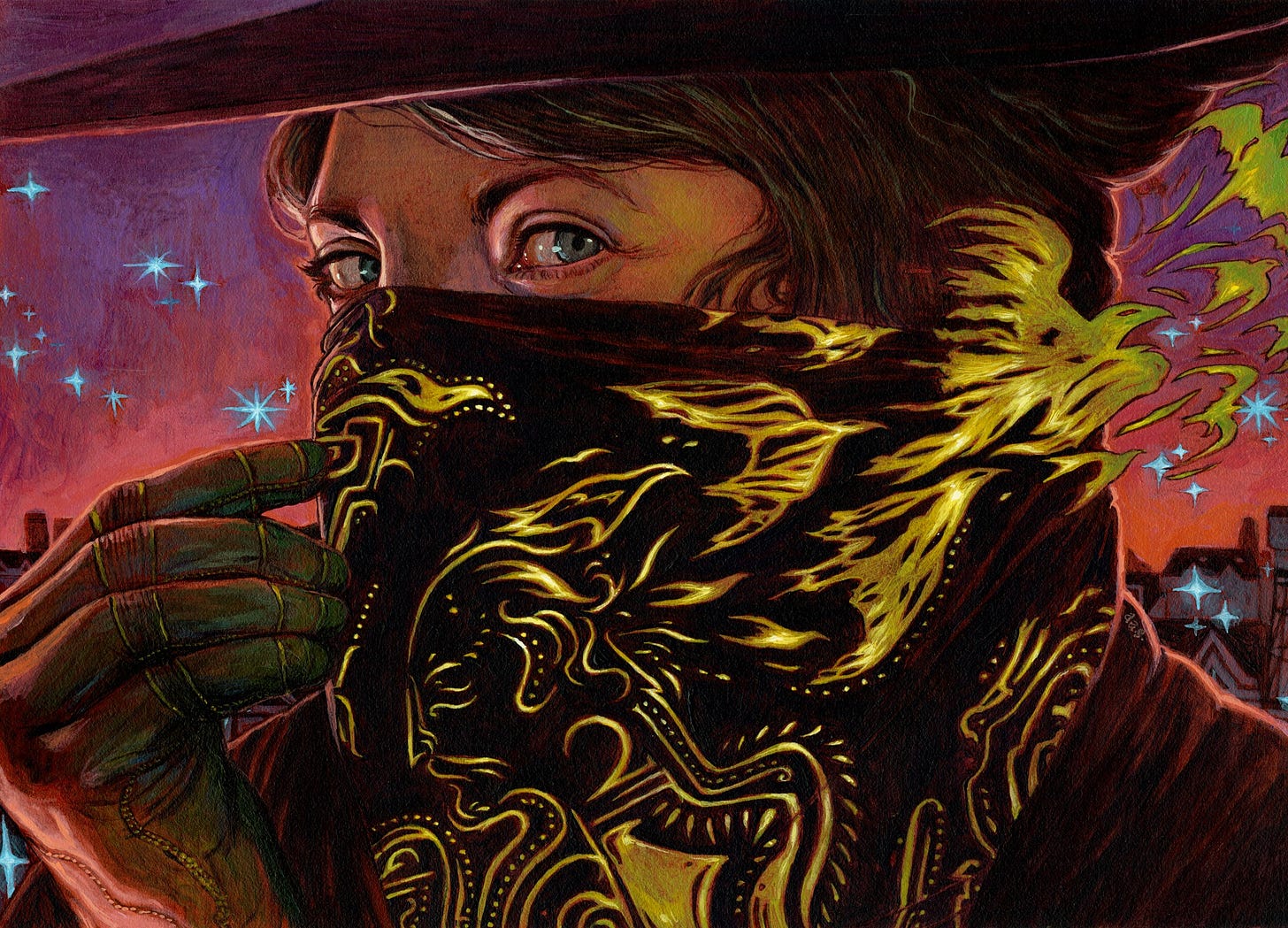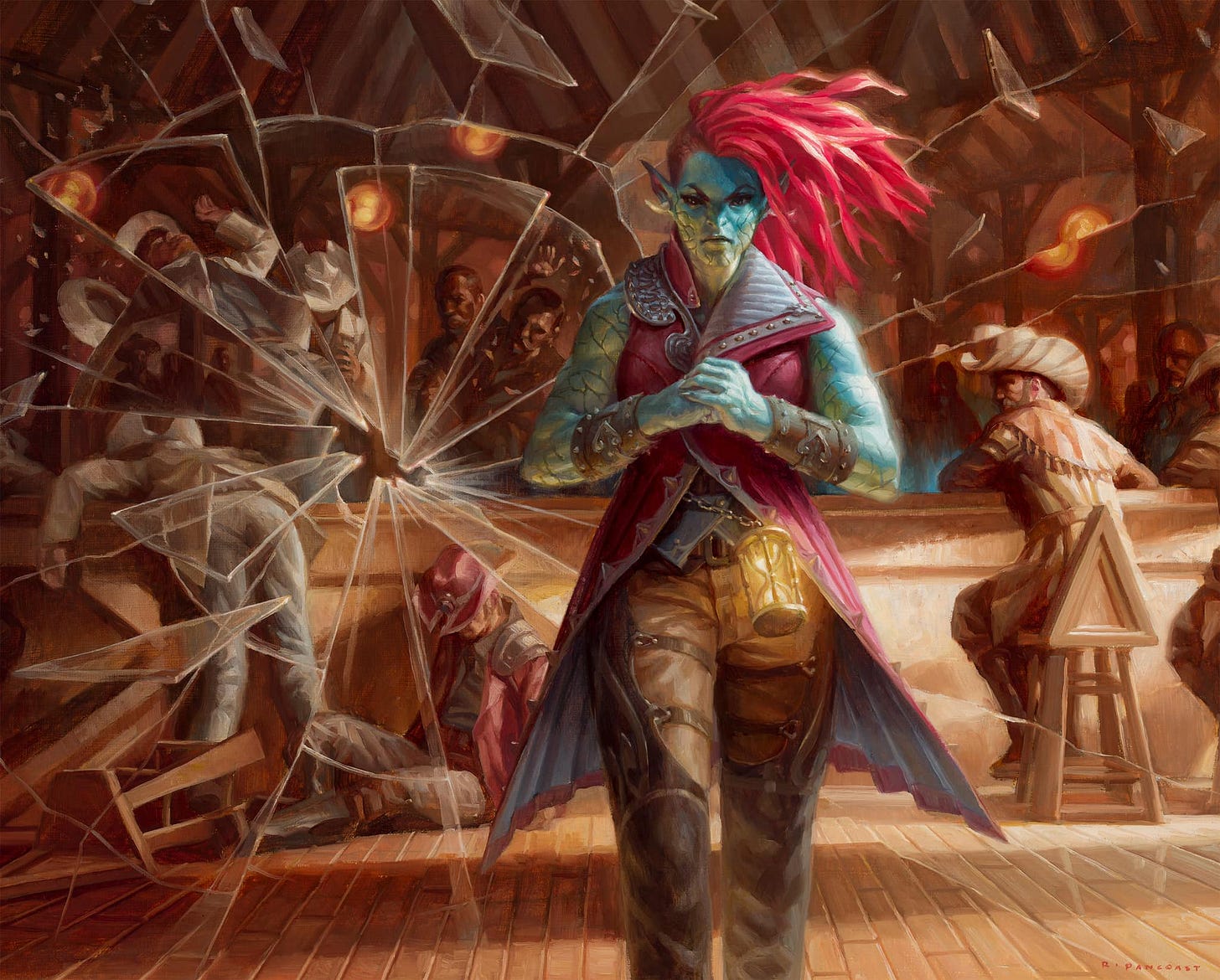Three Works: Art Highlights from Outlaws of Thunder Junction
The West three ways, and why Outlaws of Thunder Junction takes a step forward
[Author’s Note: My last art review received quite a good bit of positive feedback, of which I’m very thankful. Readers enjoyed the authenticity, honesty, and respectful criticism that is the voice of this new column, as well as the brevity that came with looking at just three works of art. That trend will continue today.]
Outlaws of Thunder Junction is Magic: The Gathering’s 100th expansion. It’s a top-down frontier fantasy full of Wild West tropes, villain showcases, and just enough science fiction to separate it from the conventional, classical reimagining of the Old West. It’s the runner-runner follow-up to another top-down set, the murder mystery laden Murders at Karlov Manor, but with several key differences elevating it beyond the “hat-land” tendencies of flavor-first attempts.
The following paintings capture the zeitgeist of this set in triplicate: the Old West, the New West, and the Wild West. In each piece the artist brings something special to the that makes it exceptional, flavorful, and ultimately, memorable. Together they begin to weave the fabric of an outstanding story, and make Outlaws of Thunder Junction a decided step-up when looking at recent releases. It’s a testament to the fact that the right artist’s make all the difference, and the end result are three incredibly strong artworks that encapsulate an entire world.
Old West- Vara Beth Hannifer by Sidharth Chaturvedi
This is the most important painting in the set, and on a card that many players will likely never see. It is emblematic of the nostalgia associated with the ‘Old West,’ heavily influenced by the Golden Age of Illustration, as is much of Chaturvedi’s work, with notes of N.C. Wyeth and Frederic Remington, masters of the genre from a hundred years ago. A forced perspective action shot of a traditional cowboy atop a wild steed, it could serve as the cover of any Western fiction novel of the early 20thC. But looking closer at the futuristic firearm (the stock edited digitally to make it seem even more fantastical), it places the work in a world completely new, and as such, completely Magic. Only in Thunder Junction could such an image, painted by such an artist, exist as this one does.
This painting should serve as a catalyst; the artwork needs to be on a legendary creature, as a part of a Secret Lair by Chaturvedi entirely in this style. With a bonus card that makes it look like a book cover. It’s the perfect emissary of this set, and should be remembered as such.
New West- Dream-Thief’s Bandana by Danny Schwartz
Danny Schwartz is one of the most exciting artists to begin working for Magic in the last twelve months, and it’s because of imagination like this. Dream-Thief's Bandana takes a very ordinary, topical object of the trope and makes it extraordinary, with a surrealist composition and the artist’s signature use of color to pull it all together. The traditional paisley so often associated with cowboys has come to life, as phoenix peel off to dance across the nighttime sky. I am immediately intrigued by the character, and want to know more about the Magic afoot here; it’s arresting and enthralling in all the right ways, and leaves the viewer both curious and satisfied at the same time.
This painting is the epitome of how Magic can push boundaries: taking something that feels old, making it new again, and then completely unique at the same time.
Wild West- Obeka, Splitter of Seconds by Ryan Pancoast
This painting tells the story of the new life brought to Magic’s characters in the Omenpath era, now by way of the Wild West. Transported and thematically cast to fit this new world and doing what she does best, Obeka’s story is adjacent to the one we see unfolding in the artwork; a bar-room brawl frozen in time, with each shard showcasing a different piece of the action. It’s hard to capture two narratives correctly, both that of the character and the overarching setting, but it’s what sets the work apart. Pancoast is a master storyteller, and he’s visually articulated everything we need to know about both character and context in a single painting.
This work is a reminder that the best in the business illustrate this game, and that each artist has something to say, and a story to tell.
End Step
Top-down sets will always create challenges for artistic creativity. Not only does an artwork need to be executed well, it has to square against hundreds, or sometimes thousands of years of historical precedent and nostalgia in order to fully resonate. And even though Outlaws of Thunder Junction is a “villains” set as opposed to “Wild West,” it has to live up to its constituents' preconceived notions about what exactly that means.
And honestly? I think it did.
This was no pastiche of a pastiche, as has happened before. Rather it was Magic reimagining a tried and true subject matter through a unique lens. Much like Murders at Karlov Manor, the set achieved a visual continuity that is very, very difficult. But this time the body of work felt more believable, and artist assignments more matched, resulting visual high notes as these that dot the landscape. The end result is an overall stronger oeuvre, and the likelihood that pieces and places from this set will be remembered well into the future.
Magic can do these sorts of sets, and do them well. Sometimes you might just need to look closer, at the cards no one else is paying attention to, to find the real gems hidden in plain sight.






